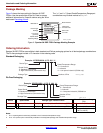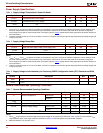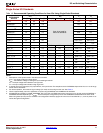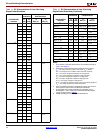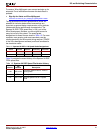
DC and Switching Characteristics
14 www.xilinx.com DS610-3 (v2.0) July 16, 2007
Product Specification
R
Quiescent Current Requirements
Table 9:
Quiescent Supply Current Characteristics
Symbol Description Device Power Typical
(2)
Commercial
Maximum
(2)
Industrial
Maximum
(2)
Units
I
CCINTQ
Quiescent V
CCINT
supply current XC3SD1800A C,I 55 390 500 mA
LI 45
- 175 mA
XC3SD3400A C,I 80 550 725 mA
LI 70
- 300 mA
I
CCOQ
Quiescent V
CCO
supply current XC3SD1800A C,I 0.4 4 5 mA
LI 0.2
-5mA
XC3SD3400A C,I 0.4 4 5 mA
LI 0.2 -5mA
I
CCAUXQ
Quiescent V
CCAUX
supply current XC3SD1800A C,I 42 90 110 mA
LI 38
-72mA
XC3SD3400A C,I 70 130 160 mA
LI 65
- 105 mA
Notes:
1. The numbers in this table are based on the conditions set forth in Table 7.
2. Quiescent supply current is measured with all I/O drivers in a high-impedance state and with all pull-up/pull-down resistors at the I/O pads
disabled. Typical values are characterized using typical devices at ambient room temperature (T
A
of 25°C at V
CCINT
= 1.2V, V
CCO
= 3.3V, and
V
CCAUX
= 2.5V). The maximum limits are tested for each device at the respective maximum specified junction temperature and at maximum
voltage limits with V
CCINT
= 1.26V, V
CCO
= 3.6V, and V
CCAUX
= 3.6V. The FPGA is programmed with a “blank” configuration data file (that
is, a design with no functional elements instantiated). For conditions other than those described above (for example, a design including
functional elements), measured quiescent current levels will be different than the values in the table.
3. There are two recommended ways to estimate the total power consumption (quiescent plus dynamic) for a specific design: a) The
Spartan-3A DSP
FPGA XPower Estimator provides quick, approximate, typical estimates, and does not require a netlist of the design. b)
XPower Analyzer uses a netlist as input to provide maximum estimates as well as more accurate typical estimates.
4. The maximum numbers in this table indicate the minimum current each power rail requires in order for the FPGA to power-on successfully.
5. For information on the power-saving Suspend mode, see XAPP480
:
Using Suspend Mode in Spartan-3 Generation FPGAs
. Suspend mode
typically saves 40% total power consumption compared to quiescent current.



